At the start of any tenancy, an inventory check-in should be carried out. This audit is in two parts, the ‘inventory’ lists all of the items and the contents of the property and the ‘check-in’ lists the condition of all of those items at the start of the tenancy along with confirmation of meter readings and the number of keys handed over to the tenant/s. The same format can then be cross-checked at the end of the tenancy and any changes in condition noted.
Inventories are traditionally written documents, but are also done as video logs of the property’s condition. They are either undertaken by the landlord, the agent or by third party inventory companies, although it’s generally considered that a third-party inventory company has less risk of bias as they conduct many reports each day. The reports are crucial for protecting both the landlord and tenant in any damage claims at the end of the tenancy as they accurately record the condition at the start and at the end of the tenancy.
According to the deposit scheme rules, if a landlord wishes to claim for damages which are subsequently disputed by the tenant, both parties will need to provide evidence to validate their claim. The inventory check-in and check-outs will be key documents to show the condition of the property at the start and end of the tenancy. You should check the document thoroughly at the start and make note of any discrepancies that you feel it may contain so that there is an agreed record right from the beginning. It is recommended that the inventories are signed. If the reports are being undertaken by a professional company, this is less important but if undertaken by the landlord directly to sign the inventory will reduce the chances of any dispute or bias.
The inventory check-in will be conducted just before you move into the property. You would be able to go through the property with the inventory clerk to record the condition of the property so that the document accurately reflects the property, its contents and the condition. It is not obligatory for you to attend but there are less likely to be disagreements or discrepancies if you do.
You should expect to have an inventory compiled for your property but if for any reason the landlord or the agent decides that they are not going to do one, it is in your interests to still record the condition of the property so as to avoid a dispute further down the line. This is more likely to happen on unfurnished properties where the landlord thinks there is less to damage but even redecoration can be expensive. If you have photographs showing the condition when you moved in, this will help rebut any unsubstantiated claims at the end of the tenancy. If the matter is referred to the deposit scheme and the landlord has not compiled an inventory it is highly unlikely that the claim for damages will be successful.
For more free advice and updates on the local property market, join the Walton Property Community on Facebook or check out our video advice library on our YouTube channel here.




